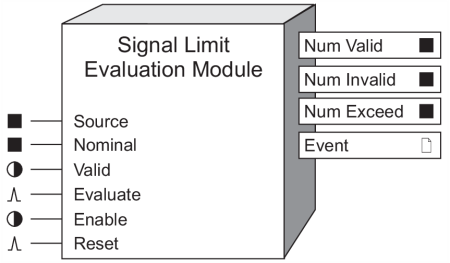Signal Limit Evaluation Module
The Signal Limit Evaluation module is designed to characterize signal deviations outside of a pair of user specified limits.
Module icon
![]()
Overview
You can specify the limits as specific values or as percentages of a nominal value.

NOTE: The registers and settings available in this module depend on the device or node you are configuring, as well as its firmware and template versions. Not all registers or settings are available on all devices or the Virtual Processor, and labels may vary.
Inputs
 Source
Source
The Source input is the signal to be characterized. This input must be linked or the module will not function.
 Nominal
Nominal
The Nominal input is linked to the nominal value of the Source input quantity (for example, nominal system voltage), and as such, is generally linked to an unchanging value. This input must be linked if the Eval Mode setup register is set to percentage.
 Valid
Valid
When the Evaluate input is pulsed, the module checks the state of Valid, and updates the output registers accordingly; refer to “Detailed Module Operation” below. Linking this input is optional.
 Enable
Enable
This input enables or disables the module’s operation. If this input is set to false, the output registers do not continue to update. This input is optional; if you leave it unlinked, the module will be enabled by default.
 Evaluate
Evaluate
A pulse at this input triggers the module to perform its statistical evaluation, and update its output registers. This input must be linked for the module to go online.
 Reset
Reset
This input resets the module’s outputs to not available until the next evaluation occurs. This input is optional; if you leave it unlinked, the input will never receive a pulse.
Setup registers
 Upper Limit
Upper Limit
This register specifies the maximum value the Source may attain before the Num Exceed output is incremented. If Eval Mode is set to percentage, then the Upper Limit is a percentage of the Nominal.
 Lower Limit
Lower Limit
This register specifies the minimum value the Source may attain before the Num Exceed output is incremented. If Eval Mode is set to percentage, then the Lower Limit is a percentage of the Nominal.
 Eval Mode
Eval Mode
This register specifies if the Upper Limit and Lower Limit setup registers are percentages of the Nominal input; if not, then the actual values in the registers are the limits.
For example, an Upper Limit setting of 120 with Eval Mode set to percentage means that any values from the Source input that are 20% greater than the Nominal will exceed the Upper Limit, causing the Num Exceed output register to increment.
 Average Source
Average Source
This register specifies whether the evaluation will be performed on the average of the Source values (collected between successive pulses on the Evaluate input), or on the Source input’s value at the time that the Evaluate input is pulsed.
 Average Nominal
Average Nominal
This register specifies whether the evaluation will be performed on the average of the Nominal values (collected between successive pulses on the Evaluate input), or on the Nominal input’s value at the time that the Evaluate input is pulsed.
 Discard Ratio
Discard Ratio
If Average Source is set to yes, the Discard Ratio defines how many Source inputs may be not available before the entire evaluation period is considered invalid. For example, if the Discard Ratio is set to 30%, and 40 out of 100 measurements are N/A (40% bad data), the interval is considered invalid. The Discard Ratio also applies to the Nominal input values if Average Nominal is set to yes.
NOTE: If the module invalidates the evaluation period based on the Discard Ratio, this overrides Valid inputs of true.
 EvPriority
EvPriority
This register allows you to set a custom priority level to certain events written to the Event output register. When EvPriority is zero, no event is written. Refer to the Event output register description for details.
Output registers
 Num Valid
Num Valid
The number of evaluation intervals over which the Valid input remained true.
 Num Invalid
Num Invalid
The number of evaluation intervals over which the Valid input was false.
 Num Exceed
Num Exceed
This register contains the number of times that the Source input fell outside of the bounds defined in the Upper Limit and Lower Limit setup registers (note that the Eval Mode setup register defines whether these bounds are relative to the Nominal input or absolute).
 Event
Event
All events are recorded in the Event register.
Possible events and their associated priority numbers are:
Event priority group | Priority | Description |
|---|---|---|
Setup Change | 10 | Input Links, setup registers or labels have been changed. |
Num Exceed Event | * | The Num Exceed output was incremented. |
* The priority of this event is user-defined in the EvPriority setup register. | ||
The Event output register stores the following information for each ION event: time stamp, priority, cause, effect, and any values or conditions associated with the cause and effect.
Detailed module operation
When a pulse is received on the Evaluate input, the module outputs are updated according to the following rules:
- Num Valid is incremented if the Valid input is true.
- Num Invalid increments if: the Valid input is false, or the Discard Ratio is exceeded while the module is averaging Source or Nominal.
- Num Exceed is incremented if the Valid input is true and the Source input (or averaged Source inputs; see Average Source setup register) has exceeded the bounds specified in either the Upper Limit or the Lower Limit setup registers.
A pulse on the Reset input causes the module outputs to be set to not available. Averaging will begin at the start of the next 1-second interval (if the module is averaging the Source or Nominal inputs).